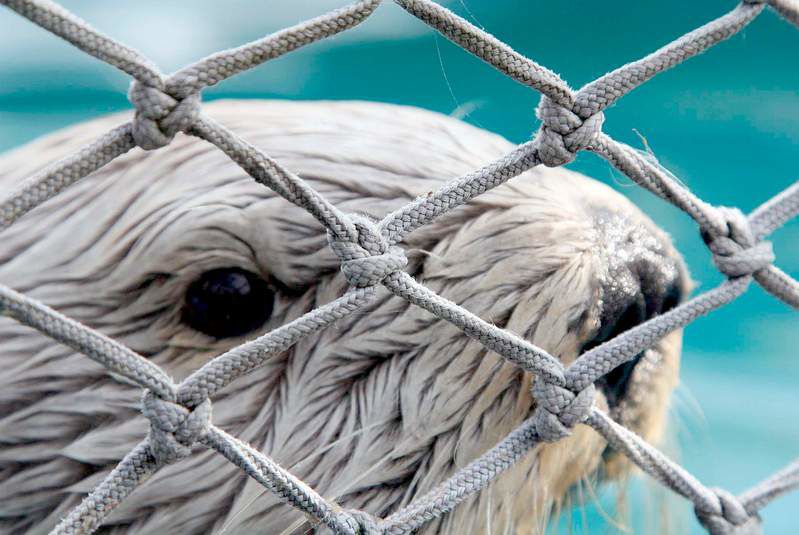Coastal clues in an otter’s whiskers
Published 5:00 am Tuesday, May 31, 2011

- A Southern sea otter is held for its safety at the Marine Wildlife and Veterinary Care Center in Santa Cruz, Calif. Scientists study otters’ whiskers to analyze their diets.
MONTEREY, Calif. — When it comes to figuring out some of the secrets of the deep, all it takes is a notebook, a stopwatch, a high-powered telescope and a seagoing mammal that happens to enjoy its meals lying on its back, holding aloft its prey for all to see.
The once almost-extinct sea otter, it turns out, is providing key insights into how human activity and shifts in ocean patterns are transforming a coastal environment that stretches from California to Canada and north to Alaska.
“Sea otters are the excellent sentinel species to tell us what’s going on with this ecosystem,” said Tim Tinker, a U.S. Geological Survey research biologist at the Western Ecological Research Center, who arrived in Alaska this month with 15 other scientists to conduct research.
A hundred years after the International Fur Seal Treaty saved otters from being hunted to extinction, a group of scientists has launched an ambitious research project drawing on old-fashioned techniques as well as cutting-edge science.
Scientists can tell from testing the animals’ blood the extent to which they’ve been subject to oil, parasites or other types of stress. They also conduct a stable isotope analysis of otters’ whiskers to chart their diet over the course of a year.
“It’s not so much ‘CSI: Sea Otters’ as it is ‘CSI: Coastal Health,’ ” said Seth Newsome, a University of Wyoming researcher who will look at the whiskers’ chemical signature as well as analyze fish muscle collected from the expedition.
“What we’re doing is a unique way of using top predators as a window into the complex changes going on,” Tinker said.
Sea otters — cousins of the common weasel — provide a perfect lens into the near-shore environment for an array of reasons. They’re at the top of the food chain, they reside in the same area year-round and they are relatively easy to observe. (Hence the telescope, notebook and stopwatch.)
Otters dive to the bottom of the sea to capture invertebrates such as urchins and mollusks, but they bring all of these creatures to surface to consume them.
They lie on their backs and eat with their prey sitting on their chest, which allows researchers to determine with precision how many calories they’re consuming and what sort of species they’re targeting.
“We literally record every prey item they collect from the bottom of the ocean,” Tinker said.
But other aspects of the three-year, multimillion-dollar project — which includes not only federal researchers but also ones from the Monterey Bay Aquarium, Seattle Aquarium, the University of Idaho, the University of Wyoming, Canada’s Department of Fisheries and Oceans and the California Department of Fish and Game — involve high-tech analysis as well.
To get a broader sense of the regions’ overall productivity, scientists will analyze satellite data to gauge the amount of chlorophyll in the near shore as well as markers in two fish species’ ear bones, or otoliths, which are similar to tree rings in terms of charting how fast the fish are growing.
In doing so the research team might also find answers to why some Pacific sea otter populations remain in trouble while others are either stable or growing. Sea otters used to be abundant throughout the north Pacific Rim, from southern California to northern Japan. But between the 1750s and the turn of the 20th century, the fur trade wiped out so many that only 13 isolated colonies, with a total of 1,000 to 2,000 animals, remained.
Since receiving international protection, some of these colonies, including those in the Prince William Sound and in southeast Alaska, are stable. The ones off Washington state’s coasts and Vancouver Island are even growing. But others, including a colony in the Alaskan peninsula, and the one here in Monterey Bay, face obstacles. Three of the nine otter populations along the U.S. and Canadian Pacific coast are listed as threatened under the Endangered Species Act.
In each of the colonies, the scientists are looking at about 60 otters. They are now conducting their last sampling expeditions and will devote next year to analyzing the data they’ve collected.
One reason sea otters are so sensitive to human pressures is that they face so many other challenges in the wild. As the world’s smallest marine mammals, they spend between 15 percent and 20 percent of their time grooming their dense fur because they lack blubber to keep themselves warm. They also must consume a quarter of their body weight each day, which means they’re limited to coastal areas where food is most abundant.
“We’re looking at a species that really lives, in the best of times, on a razor’s edge,” said Mike Murray, the Monterey Bay Aquarium’s staff veterinarian.






